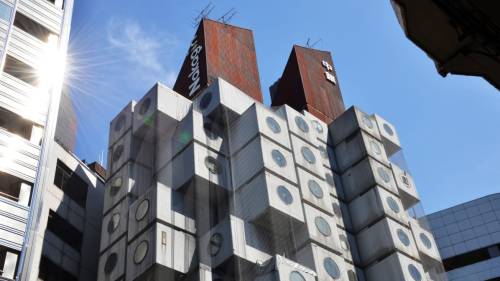#tokyo japan
“You Are The Art”
This was supposed to be a very different concept when I first started working on it. However, the base colors I had for the background reminded me of the digital art museum I went to in Tokyo. So I ended up changing the concept completely to make it seem like Jimin was sitting in one of the rooms at Teamlab Borderless, Tokyo!
-
-
DIGITAL ART
Instagram:@/_gxner_
twitter: @/gxner_art
redbubble! see link below
-
[ DO NOT REPOST WITHOUT PERMISSION, THANK YOU ] <3
Post link
Tokyo’s Iconic Nakagin Capsule Tower to be Demolished
One of Japan’s most distinctive works of contemporary architecture, the Nakagin Capsule Tower in Tokyo, will be demolished this month, according to the building’s new owners.
The decision ends years of uncertainty surrounding the eye-catching structure, which once offered a futuristic vision of urban living but had recently fallen into disrepair.
Completed in 1972, the tower comprises 144 factory-built units arranged around two concrete cores. Each 10-square-meter (108-square-foot) “capsule” features a porthole-style window, with appliances and furniture built into the structure of each home.
The building is considered a prime example of Metabolism, an architectural movement that emerged from the ruins of World War II with a radical new vision for Japan’s cities. As well as embracing technology and mass production, the avant-garde group’s members looked to nature for inspiration, with structural components treated like organic cells that could be “plugged” into a larger whole or later replaced.
The building’s designer, Kisho Kurokawa – one of Metabolism’s youngest adherents – had originally envisaged the Tokyo tower’s capsules being replaced every 25 years. But they instead grew dilapidated and outdated, with many of the apartments now sitting empty, used for storage and office space, or rented out to architecture enthusiasts on a short-term basis.
In 2007, the owners’ association voted to sell the tower to a property developer that intended to demolish and replace it. But the firm filed for bankruptcy during the 2008 recession, and the site’s fate was thrown into years-long limbo.
Owners again agreed to sell in 2021, and the building was acquired by a group of real estate firms operating under the name Capusule Tower Building (CTB). A spokesperson for the joint venture, Takashi Shindo, said over the phone that the last residents moved out last month, with demolition scheduled to begin April 12.
Preservationists had long expressed hope that the building might be saved – including Kurokawa, before his death in 2007. Petitions and campaigns have called for the structure to be protected as an example of Japan’s architectural heritage.
Although the Metabolism movement proved influential, very few of its proposals were ever realized, making Nakagin Capsule Tower a rare living example of the group’s philosophy.
The organization behind the conservation campaign, the Nakagin Capsule Tower Building Preservation and Regeneration Project, asked city authorities to intervene – and even considered applying for protected status with UNESCO. But neither approach proved successful, according to project member Tatsuyuki Maeda, who acquired 15 of the capsules between 2010 and the building’s sale last year.
“Japan does not have the legislation to preserve this kind of architectural culture,” he said over the phone. “It is unfortunate that one of the country’s most representative examples of modern architectural heritage will be lost.”
This ‘zero waste’ Japanese building is made from 700 donated windows
Maeda said that efforts to raise the 2 to 3 billion yen ($16 million to $24 million) required to renovate the tower and remove asbestos were hampered by the Covid-19 pandemic. The project has since shifted focus towards raising funds to refurbish and repurpose individual units in the hope that institutions might look to acquire “unplugged” capsules.
Maeda said the project has received around 80 inquiries, with the Centre Pompidou in Paris among the museums to have expressed interest in obtaining one, he added. The Museum of Modern Art in Saitama, Japan, meanwhile has a unit in its collection already.
Kurokawa’s architecture firm, which continued operating after his death, announced that it intends to preserve the building in a “digital space.”
“We are determined to preserve the capsules, even if the building is demolished,” said Maeda. “Dozens of capsules with relatively little aging will be recovered and rehabilitated.
"There is no doubt that the building was famous, but the Capsule Tower also had a certain charm that appealed to people. Everyone who stayed there was creative in his or her own way, and the community that formed was truly fascinating. I am sad to see it go, but I hope it will live on in a new form.”
Post link

tokyo’s shibuya crossing


gogo yubari, kill bill vol. 1, 2003










I have had enough of this life. I wanna live and die in the Ghibli World.
Ghibli Rooms and it’s poetic sensibility.
Films in Frame - Kiki’s delivery service, When Marnie was there, Whisper of the heart, Only Yesterday, Ocean waves, Howls moving castle, From up on poppy hills, The secret World of Arrietty, My neighbour totoro
Rainbow Bridge, Tokyo, Japan
The Rainbow Bridge is a suspension bridge crossing northern Tokyo Bay between Shibaura Pier and the Odaiba waterfront development in Minato, Tokyo, Japan.
It was built by Kawasaki Heavy Industries, with construction starting in 1987 and completed in 1993. The bridge is 798 metres (2,618 ft) long with a main span of 580 metres (1,903 ft). Officially called the “Shuto Expressway No. 11 Daiba Route - Port of Tokyo Connector Bridge,” the name “‘Rainbow Bridge” was decided by the public.
The towers supporting the bridge are white in color, designed to harmonize with the skyline of central Tokyo seen from Odaiba. There are lamps placed on the wires supporting the bridge, which are illuminated into three different colors, red, white and green every night using solar energy obtained during the day.
The bridge can be accessed by foot from Tamachi Station (JR East) or Shibaura-futō Station (Yurikamome) on the mainland side.
Post link











